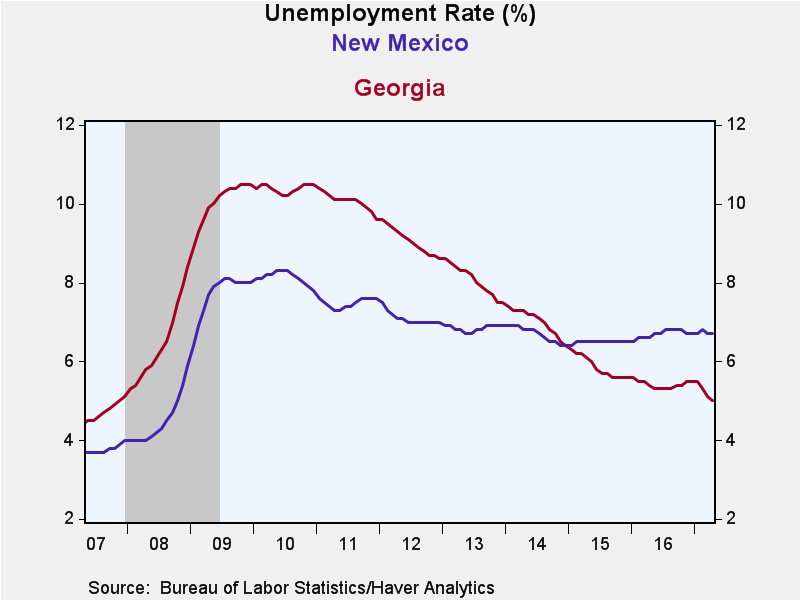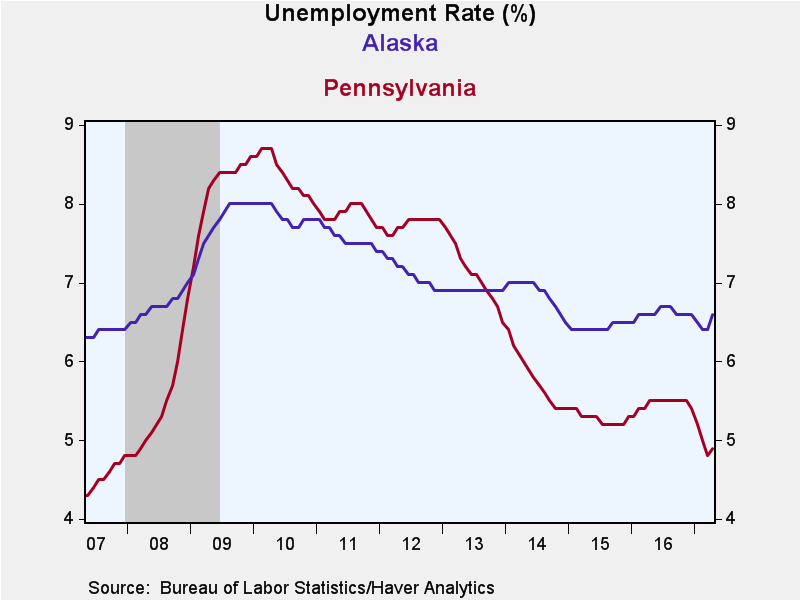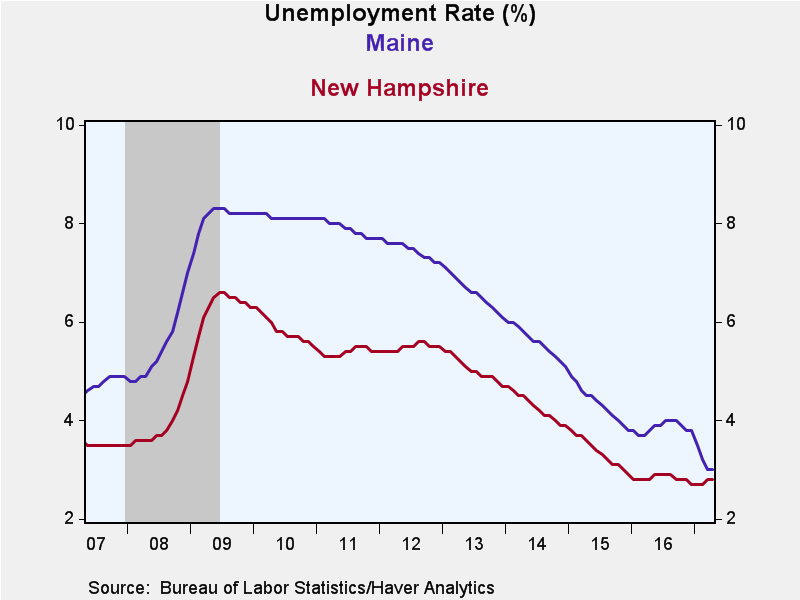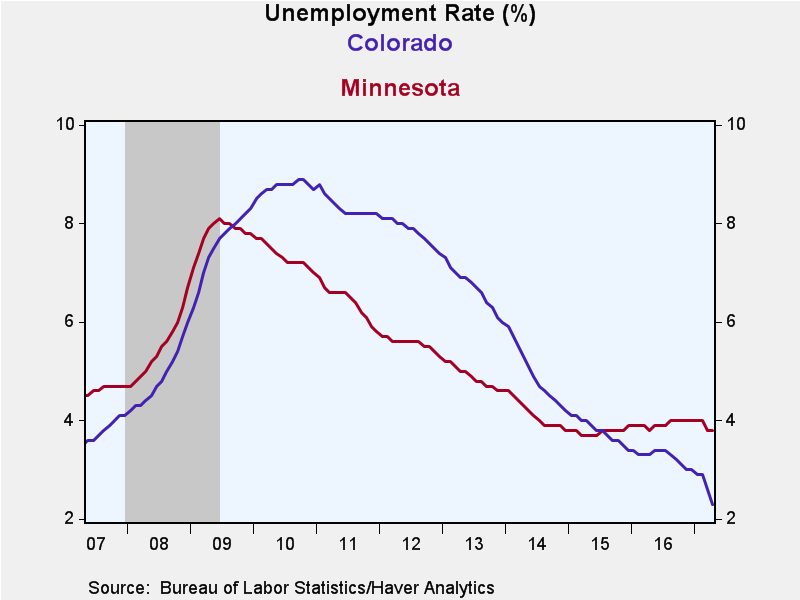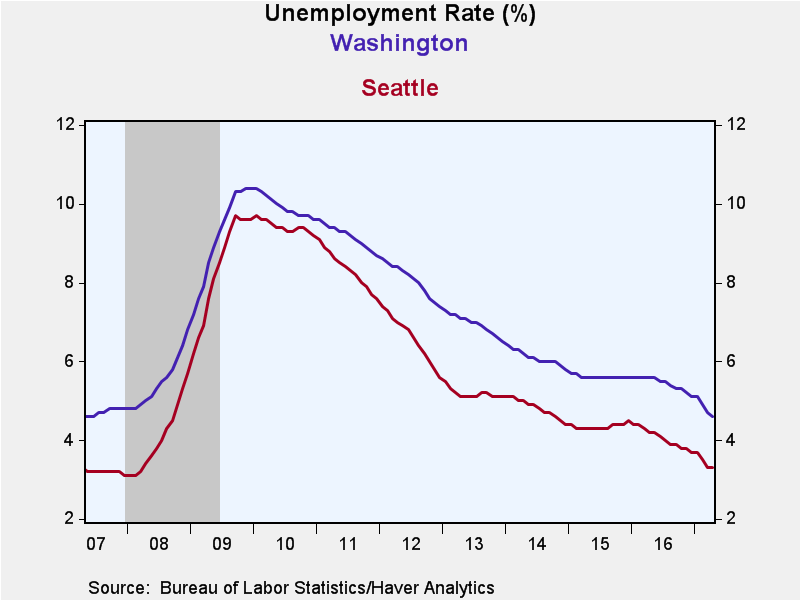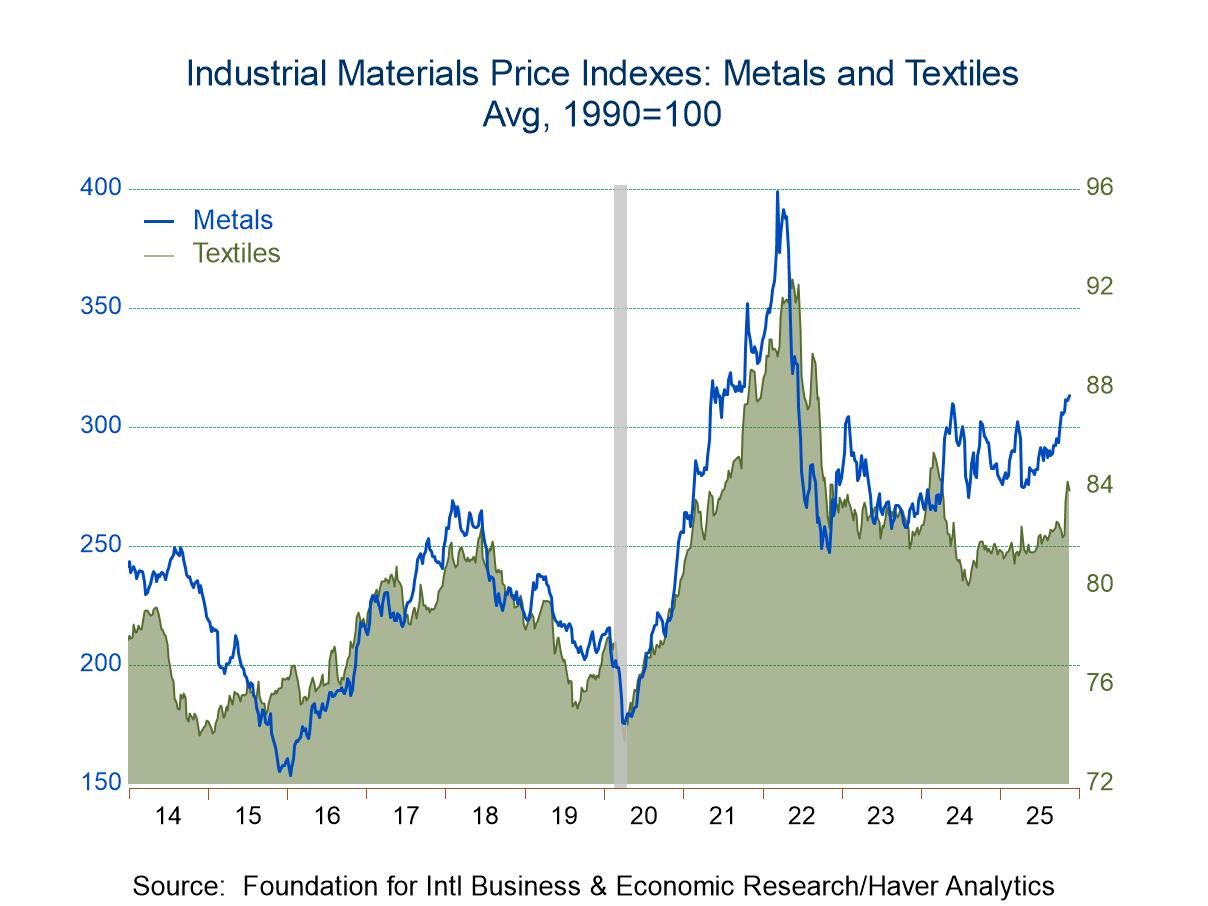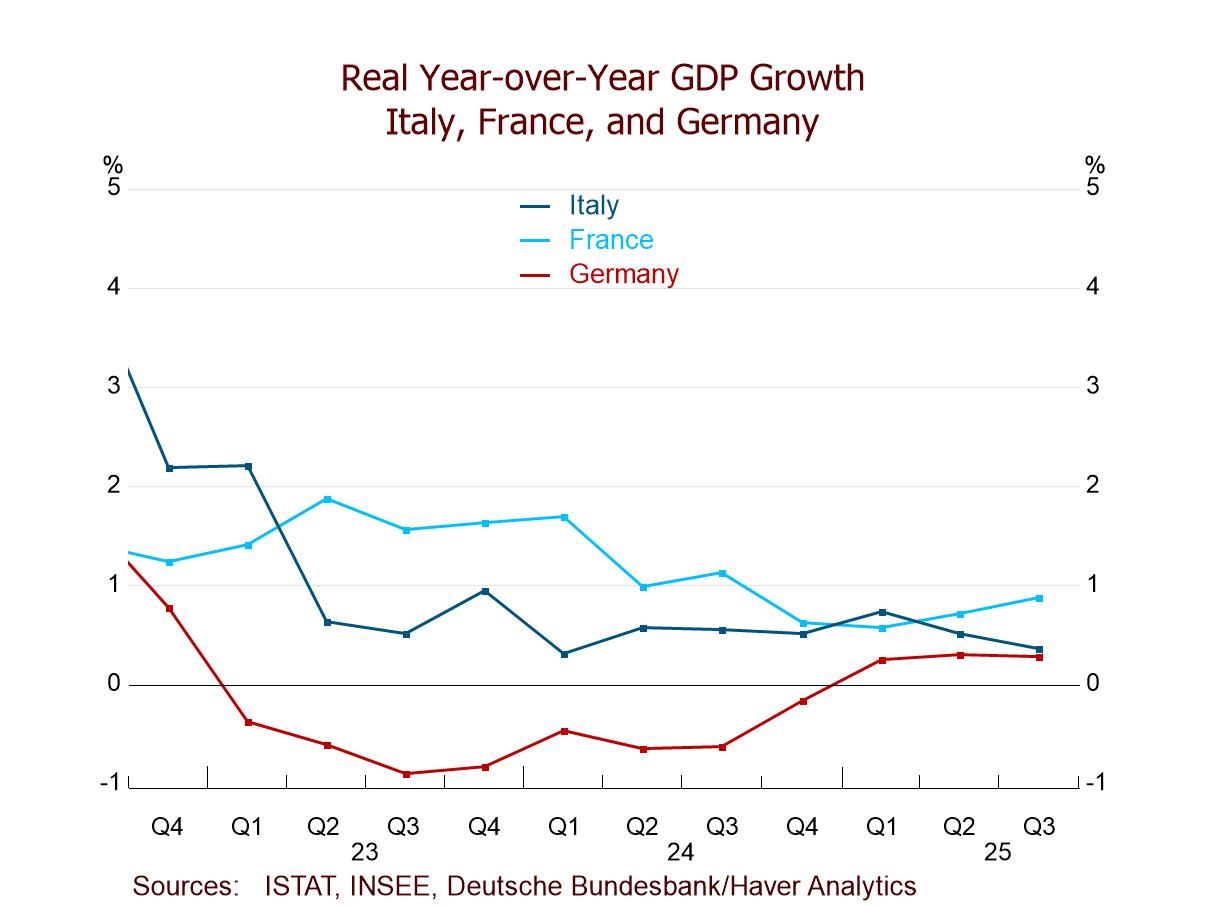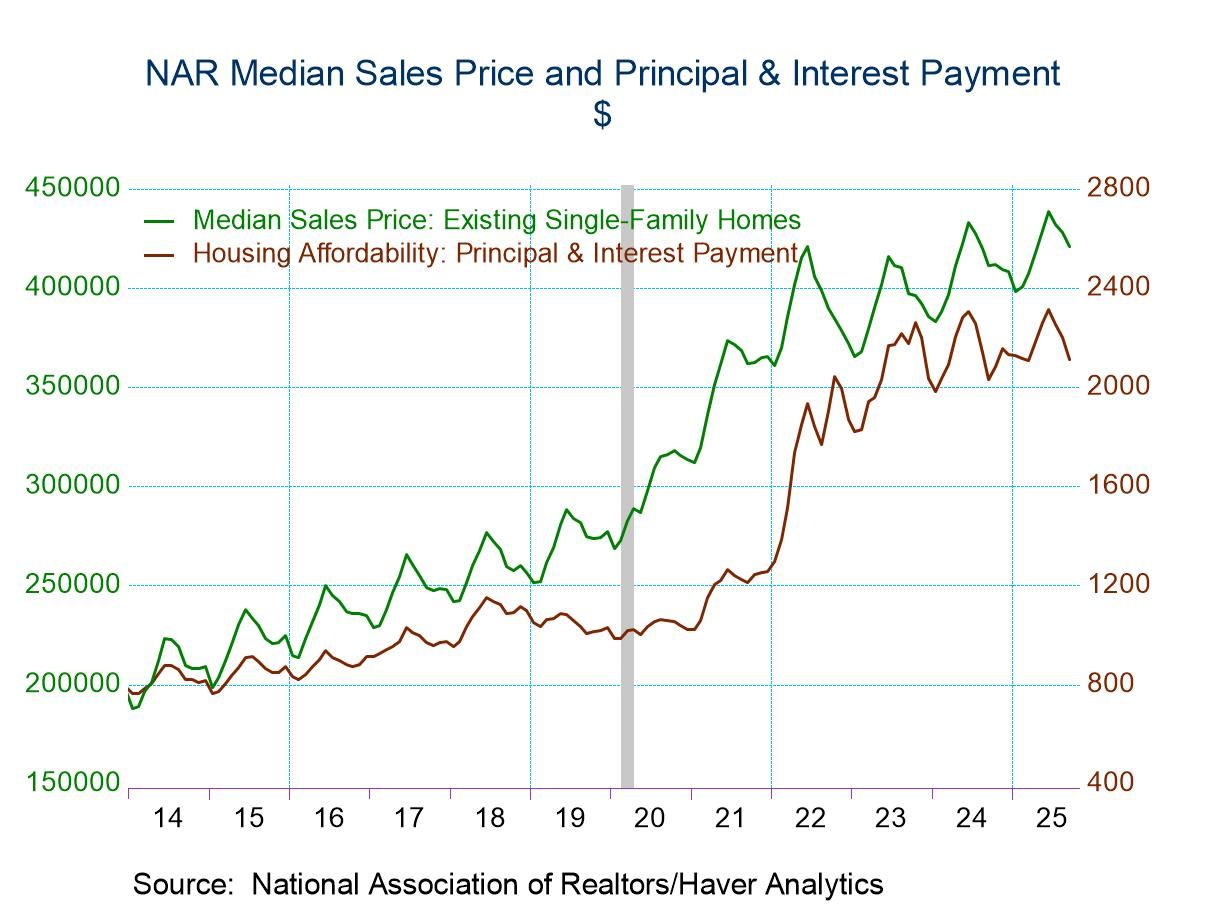 Global| May 19 2017
Global| May 19 2017U.S. Unemployment Varies Greatly Around the Country
by:Tom Moeller
|in:Economy in Brief
Summary
As the U.S. unemployment rate declined last month to 4.4%, the lowest level since May 2007, it continued to reflect a wide range of rates amongst states. At the high end were two states which realized unemployment above 6.0%. Several [...]
As the U.S. unemployment rate declined last month to 4.4%, the lowest level since May 2007, it continued to reflect a wide range of rates amongst states. At the high end were two states which realized unemployment above 6.0%. Several states, however, continued to experience an unemployment rate below 3.0%.
New Mexico's jobless rate continued to top the charts at 6.7%. It has risen from 6.4% in early-2015. Employment and labor force growth have been subdued near 1.0%. Alaska's unemployment rate moved up slightly last month to 6.6%, but it recently trended lower as employment growth picked up to 1.6% y/y after a 0.8% decline last year. Louisiana registered a high unemployment rate of 5.8%. That was down from 6.2% a year ago, but employment and the size of the labor force both eased y/y. In Georgia, the jobless rate eased to a still-high 5.0%. Its decline has been accompanied by 3.0% growth in the labor force set against 0.8% in the country overall. In Pennsylvania, unemployment of 4.9% was down from 5.5% during the last twelve months and stood at its ten-year low. Employment grew 1.0% y/y versus 0.4% growth in the labor force.
Colorado's 2.3% unemployment remained at the low end of the range. It reflected 3.4% y/y employment growth while the labor force grew 2.4% y/y. New England continued to experience low unemployment. New Hampshire's unemployment rate of 2.8% reflected 0.8% y/y growth in both employment and the labor force. In Maine, the labor market was more dynamic. A record-low jobless rate of 3.0% reflected 3.1% y/y growth in jobs and 2.2% y/y growth in the labor force. A higher 3.9% rate of unemployment in Massachusetts reflected 3.1% y/y growth in employment and 3.0% growth in the labor pool. Further to the west, Minnesota's 3.8% unemployment rate was low as employment grew 1.2% y/y, and the labor force grew 1.1% y/y.
Amongst other large states, Ohio's 5.0% rate of unemployment reflected 1.3% y/y growth in both jobs & the size of the labor pool. Texas unemployment at 5.0% occurred as employment grew 2.1% y/y and the labor force expanded 2.5% y/y. Similarly, North Carolina's 4.7% unemployment reflected 2.4% y/y growth in employment and a 2.1% rise in the labor force. At the low end of the range amongst large states was Wisconsin which experienced 3.2% unemployment as employment rose 2.0% y/y, twice the growth in the labor force.
Within large cities, New York City's jobless rate plummeted to 4.1% from 5.2% last April, as employment grew 3.7% y/y and the labor force expanded 2.5% y/y. Unemployment in New York state was a slightly higher 4.3%, still down from a 2009 high of 8.9%. Unemployment around Chicago fell sharply to 4.3% from 6.0% last April, compared to 4.7% in all of Illinois. The city's low jobless rate reflected, however, a 0.2% y/y slip in employment set against a 1.9% y/y decline in the labor force. California's 4.8% unemployment rate exceeded the 4.5% rate around Los Angeles where employment grew 2.3% y/y and the labor force expanded 1.5%. In Washington state, 4.6% unemployment compared to 3.3% around Seattle where a 3.3% y/y gain in employment was accompanied by a 2.3% rise in the labor force.
State unemployment figures are available in Haver's EMPLR database.
Hey, Economist! Is Now a Good Time to Be Graduating from College? from the Federal Reserve Bank of New York can be found here.
| Apr | Mar | 2016 | 2015 | 2014 | Labor Force | |
|---|---|---|---|---|---|---|
|
Total U.S. Unemployment Rate (%) |
4.4% | 4.5% | 4.8 | 5.3 | 6.2 | 159.5 million |
|
Ten States With Highest Jobless Rate |
||||||
| New Mexico | 6.7 | 6.7 | 6.7 | 6.5 | 6.7 | 0.9 |
| Alaska | 6.6 | 6.4 | 6.6 | 6.4 | 6.9 | 0.4 |
| Louisiana | 5.8 | 5.7 | 6.1 | 6.3 | 6.3 | 2.1 |
| Alabama | 5.4 | 5.8 | 6.0 | 6.1 | 6.7 | 2.2 |
| Georgia | 5.0 | 5.1 | 5.4 | 5.9 | 7.0 | 4.9 |
| Pennsylvania | 4.9 | 4.8 | 5.5 | 5.3 | 5.8 | 6.4 |
| West Virginia | 4.8 | 4.9 | 6.0 | 6.7 | 6.6 | 0.8 |
| California | 4.8 | 4.9 | 5.4 | 6.2 | 7.5 | 19.1 |
| Illinois | 4.7 | 4.9 | 5.9 | 5.9 | 7.0 | 6.5 |
| Washington | 4.6 | 4.7 | 5.4 | 5.6 | 6.1 | 3.6 |
| Ten States With Lowest Jobless Rate | ||||||
| Massachusetts | 3.9 | 3.6 | 3.7 | 4.8 | 5.7 | 3.6 |
| Minnesota | 3.8 | 3.8 | 3.9 | 3.8 | 4.1 | 3.0 |
| Indiana | 3.6 | 3.9 | 4.5 | 4.8 | 5.9 | 3.3 |
| Arkansas | 3.5 | 3.6 | 4.0 | 5.0 | 6.0 | 1.3 |
| Iowa | 3.1 | 3.1 | 3.7 | 3.8 | 4.2 | 1.7 |
| Maine | 3.0 | 3.0 | 3.9 | 4.3 | 5.6 | 0.7 |
| New Hampshire | 2.8 | 2.8 | 2.8 | 3.4 | 4.3 | 0.7 |
| South Dakota | 2.8 | 2.8 | 2.8 | 3.1 | 3.4 | 0.5 |
| Hawaii | 2.7 | 2.7 | 3.0 | 3.6 | 4.4 | 0.7 |
| Colorado | 2.3 | 2.6 | 3.3 | 3.8 | 4.9 | 2.9 |
| Jobless Rate In Other Selected Large States | ||||||
| Ohio | 5.0 | 5.1 | 5.0 | 4.9 | 5.7 | 5.7 |
| Michigan | 4.7 | 5.0 | 5.0 | 5.4 | 7.1 | 4.8 |
| Texas | 5.0 | 5.0 | 4.7 | 4.4 | 5.0 | 13.3 |
| North Carolina | 4.7 | 4.9 | 5.1 | 5.7 | 6.2 | 4.9 |
| Florida | 4.5 | 4.8 | 4.9 | 5.3 | 6.2 | 9.8 |
| New York | 4.3 | 4.3 | 4.9 | 5.3 | 6.3 | 9.6 |
| Maryland | 4.3 | 4.3 | 4.3 | 5.0 | 5.8 | 3.2 |
| New Jersey | 4.1 | 4.2 | 5.0 | 5.8 | 6.7 | 4.5 |
| Virginia | 3.8 | 3.8 | 4.1 | 4.4 | 5.2 | 4.2 |
| Wisconsin | 3.2 | 3.4 | 4.2 | 4.5 | 5.4 | 3.1 |
Tom Moeller
AuthorMore in Author Profile »Prior to joining Haver Analytics in 2000, Mr. Moeller worked as the Economist at Chancellor Capital Management from 1985 to 1999. There, he developed comprehensive economic forecasts and interpreted economic data for equity and fixed income portfolio managers. Also at Chancellor, Mr. Moeller worked as an equity analyst and was responsible for researching and rating companies in the economically sensitive automobile and housing industries for investment in Chancellor’s equity portfolio. Prior to joining Chancellor, Mr. Moeller was an Economist at Citibank from 1979 to 1984. He also analyzed pricing behavior in the metals industry for the Council on Wage and Price Stability in Washington, D.C. In 1999, Mr. Moeller received the award for most accurate forecast from the Forecasters' Club of New York. From 1990 to 1992 he was President of the New York Association for Business Economists. Mr. Moeller earned an M.B.A. in Finance from Fordham University, where he graduated in 1987. He holds a Bachelor of Arts in Economics from George Washington University.


